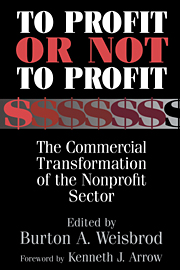Book contents
- Frontmatter
- Contents
- List of contributors
- Foreword by Kenneth J. Arrow
- Preface
- 1 The nonprofit mission and its financing: Growing links between nonprofits and the rest of the economy
- Part I Basic issues and perspective
- 2 Competition, commercialization, and the evolution of nonprofit organizational structures
- 3 Modeling the nonprofit organization as a multiproduct firm: A framework for choice
- 4 Pricing and rationing by nonprofit organizations with distributional objectives
- 5 Differential taxation of nonprofits and the commercialization of nonprofit revenues
- 6 Interdependence of commercial and donative revenues
- 7 Conversion from nonprofit to for-profit legal status: Why does it happen and should anyone care?
- Part II Industry studies
- Part III Overview, conclusions, and public-policy issues
- Appendix: IRS Forms 990 and 990-T for nonprofit organizations
- References
- Index
3 - Modeling the nonprofit organization as a multiproduct firm: A framework for choice
Published online by Cambridge University Press: 30 November 2009
- Frontmatter
- Contents
- List of contributors
- Foreword by Kenneth J. Arrow
- Preface
- 1 The nonprofit mission and its financing: Growing links between nonprofits and the rest of the economy
- Part I Basic issues and perspective
- 2 Competition, commercialization, and the evolution of nonprofit organizational structures
- 3 Modeling the nonprofit organization as a multiproduct firm: A framework for choice
- 4 Pricing and rationing by nonprofit organizations with distributional objectives
- 5 Differential taxation of nonprofits and the commercialization of nonprofit revenues
- 6 Interdependence of commercial and donative revenues
- 7 Conversion from nonprofit to for-profit legal status: Why does it happen and should anyone care?
- Part II Industry studies
- Part III Overview, conclusions, and public-policy issues
- Appendix: IRS Forms 990 and 990-T for nonprofit organizations
- References
- Index
Summary
Introduction
To understand why nonprofits are exhibiting a stepped-up involvement in commercial activities – expanding into new areas of activity, entering increasingly into business arrangements with private industry, pricing and advertising more aggressively, and, in general, doing things that are novel for nonprofits but commonplace for private firms – we need to understand their goals, or missions, and the financial constraints on attaining them. This chapter presents the theoretic framework with which we analyze nonprofit organization commercial activities in the chapters that follow. Our focus is on private nonprofit organizations, although most of the analysis applies to government organizations as well.
The decision by a nonprofit organization to produce a particular output, make it available to particular consumers, and finance it through specific finance mechanisms, reflects choices: whether to use revenue-raising techniques typically associated with private enterprise, such as entering new markets in order to generate profits, charging fees that raise revenue but restrict access in the process, and generally acting like profit-maximizing private firms; or to act differently from private firms, avoiding particular markets or revenue-raising opportunities that might conflict with their goals. Nonprofit organizations and private firms can be expected to make different decisions about engagement in “commercial” activities – profit-oriented actions in forms and degrees associated with private firms – if they have different goals or different opportunities and incentives.
Incentives are important here. Nonprofit charitable organizations can receive tax-deductible donations, whereas private firms cannot; as a result, each has a vastly different degree of dependence on donations.
- Type
- Chapter
- Information
- To Profit or Not to ProfitThe Commercial Transformation of the Nonprofit Sector, pp. 47 - 64Publisher: Cambridge University PressPrint publication year: 1998
- 44
- Cited by

